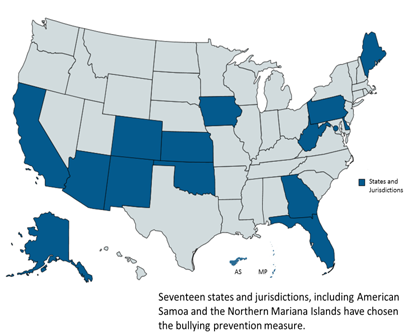Research confirms what many public health practitioners, educators, parents, and children have long known—that bullying is a serious issue facing our nation. In October of 2014, HRSA’s Maternal and Child Health Bureau shared its vision to activate support on this important challenge by establishing bullying prevalence as one of 15 new National Performance Measures for the Title V Maternal and Child Health (MCH) Block Grant Program.

The MCH Block Grant Program provides funds to 59 states and jurisdictions to address the health service needs of mothers, infants, children, adolescents and families. Through this program, each state and jurisdiction supports and promotes the development and coordination of quality care systems for the MCH population which are family-centered, community-based and culturally appropriate.
In September of this year, states and jurisdictions selected 8 National Performance Measures on which to focus, and 17 states and jurisdictions selected the bullying performance measure. These states and jurisdictions will consider the percentage of youth who are bullied as one of their key indicators of the health and wellness of MCH populations. The decision to focus on the reduction of bullying is a tremendous step forward in the multi-disciplinary efforts to prevent bullying.
In an effort to inform bullying prevention technical assistance activities for states and jurisdictions, the Children’s Safety Network (CSN) performed a bullying prevention environmental scan. CSN invited state MCH program directors and state Injury and Violence Prevention program directors in all 50 states and the District of Columbia to share perspectives on existing bullying prevention work. Forty-two states responded. Results highlighted the significant engagement of public health departments in bullying prevention, as well as challenges and opportunities to reduce bullying among children and youth. Among the findings were:
- 57% of the responding states indicated that their state public health agency is involved in bullying prevention.
- The most common forms of involvement include:
- providing information and education about prevention and response (66% of respondents),
- providing training and technical assistance (63%),
- collecting and disseminating data on bullying (54%),
- designing and implementing prevention and response efforts (54%),
- facilitating collaboration between relevant organizations and professionals (50%), and
- funding local programs (50%).
In addition, HRSA has partnered with several public and private sector organizations to support a Consensus Study by the Institute of Medicine to produce expert recommendations which can inform policy, practice and future research on bullying prevention. The resulting report, anticipated in early 2016, will provide guidance on the most promising pathways to improve outcomes for youth involved in peer victimization.
As the global response moves from raising awareness about bullying to catalyzing action in prevention, the role of MCH programs is poised to evolve as well. MCH programs have an opportunity to leverage existing partnerships and build new alliances to facilitate state-level collaboration in advancing effective policies and practices that protect all youth involved in bullying. HRSA and the Children’s Safety Network look forward to supporting states and jurisdictions in their efforts to address this urgent public health concern.

